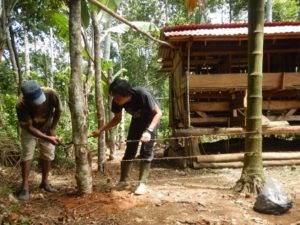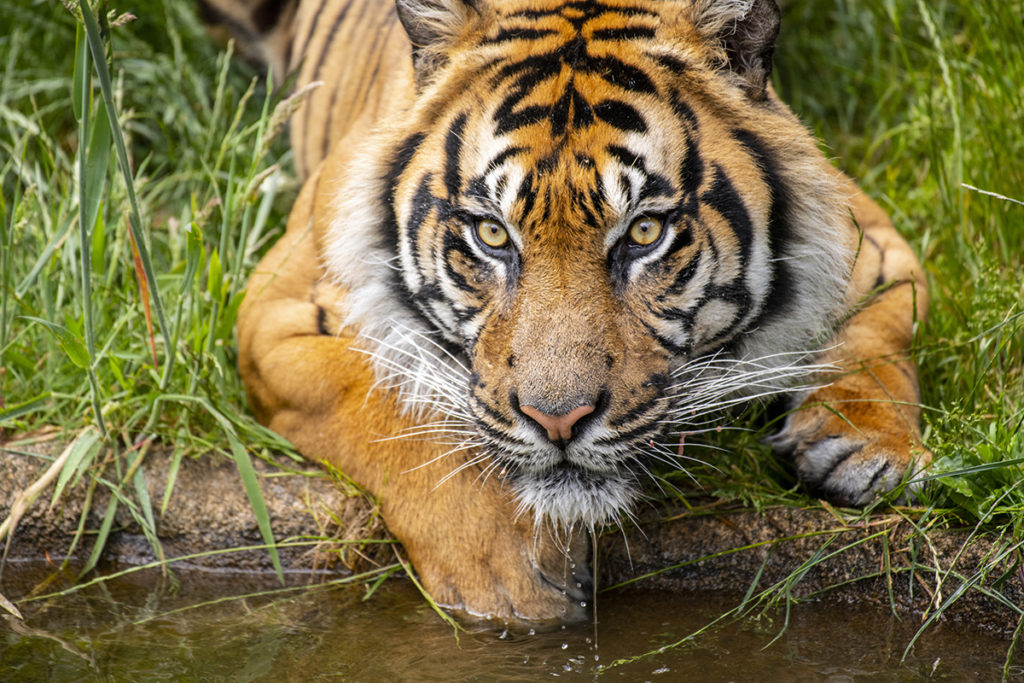Faced with the knowledge that only 400 animals of a vital species were left in the whole world, what would you do?
Would you help them have more cubs? Try to build up their habitat and prey? Make sure nobody killed them unnecessarily?
The answer is all three – and that’s exactly what organizations around the world are doing to save tigers. And for Sumatran tigers in particular, Point Defiance Zoo & Aquarium is helping through science, funding, caring for zoo tigers and spreading the word.
With fewer than 4,000 tigers left on our planet – and fewer than 400 Sumatran tigers in the wild – we are taking a good look at how we’re helping save tigers from extinction – and how you can help.
Science, cubs and caring

The first way Point Defiance Zoo helps tigers in the wild is by building up the tiger population in zoos.
“Keeping species healthy in human care has been vital to stopping extinctions in the wild,” says Point Defiance Zoo’s general curator Dr. Karen Goodrowe.
American red wolves are one such crucial species that zoos (including ours) have helped to save. Point Defiance Zoo has cared for Sumatran tigers since 2004, helping our community learn about and love tigers, and find out how to help protect them in the wild.
Just as importantly, though, we use science to make sure zoo tigers in North America and the world have the best chance of healthy, genetically diverse cubs – a backup population for those in the wild, when their habitat is stable enough.

To make the most of the genes they have, zoos share a list of all the tigers in human care, along with their genetic make-up. Reproductive biologists like Dr. Goodrowe (who coordinates the Association of Zoos & Aquariums’ tiger Species Survival Plan®) study them and determine which animals would make the best genetic match. Then they take into account each animal’s personality, age, behavior and history, as well as location, and make recommendations for moving animals to different zoos for breeding. Our five tigers currently at the Zoo are all potential mates – fingers crossed for cubs!
Dr. Goodrowe and her SSP colleagues also collaborate with zoos on the ground in Indonesia, Australasia, Europe and Japan, sharing care and breeding knowledge to strengthen their own tiger populations.
What you can do: Visit our tigers here at Point Defiance Zoo (or elsewhere) and get inspired by their beauty, power and skill. Then use your voice to tell others about the problem, and how to help. Consider donating to our Dr. Holly Reed Conservation Fund – donations earmarked for tigers will go directly to the Tiger Conservation Campaign in Indonesia.
Stopping poaching and trade

It sounds obvious, but to keep tigers from becoming extinct we have to protect the ones alive right now. Point Defiance Zoo has given $72,500 over the last 10 years to do exactly that. Our Dr. Holly Reed Conservation Fund has supported the AZA SSP Tiger Conservation Campaign, which sends money and training directly to wildlife groups in Indonesia that track poachers using technology, educate locals and build tiger-proof livestock pens to reduce human-tiger conflicts, and crack down on the illegal trade of tiger products like skin, bones and body parts.
And it’s working.
“We’ve definitely seen less poaching in the last few years,” reports Dr. Goodrowe Beck. “It’s a hopeful sign.”
Still, over 100 tigers are killed each year for the illegal wildlife trade. With only 4,000 left in the world – and fewer than 400 Sumatran tigers in the wild – that’s not a good number.

Another way to tackle the problem is to enforce the law. In 2015, voters overwhelmingly passed the Washington Animal Trafficking Act that bans the trafficking of products from ten groups of endangered animals. And in 2018, the state legislature approved $300,000 to pay for airport enforcement officers, K-9 detection dogs and lab testing of evidence to apprehend offenders. Point Defiance Zoo helped support this, and continued with a Toss the Tusk event in 2019 to allow the community to donate unwanted (now illegal for sale) wildlife products.
What you can do: Avoid buying wildlife products, especially overseas, and support laws that protect endangered species. Check products on the Wildlife Trafficking Alliance website to see if they harm tigers.
Building up habitat

The third biggest threat to tigers in the wild after poaching and trading is habitat loss.
Sumatran tigers are especially challenged, living on a single island where dwindling tiger populations are cut off from each other by roads and farms.
The Tiger Conservation Campaign helps protect habitat from illegal logging, and works with the Indonesian government as it seeks to create wildlife corridors between tiger refuges.
Protecting rainforest also helps protect the prey that tigers need to survive – we can all help.
What you can do: Buy products that use sustainable palm oil to avoid cutting down more forest. (Search on the Cheyenne Mountain Zoo shopping app to find them.)
Is there hope?
So is there hope to save tigers? We think so.
“Tigers are one of the world’s most endangered species,” says Dr. Goodrowe Beck. “We need them for healthy ecosystems and future generations. But if we work together, we can save them.”
